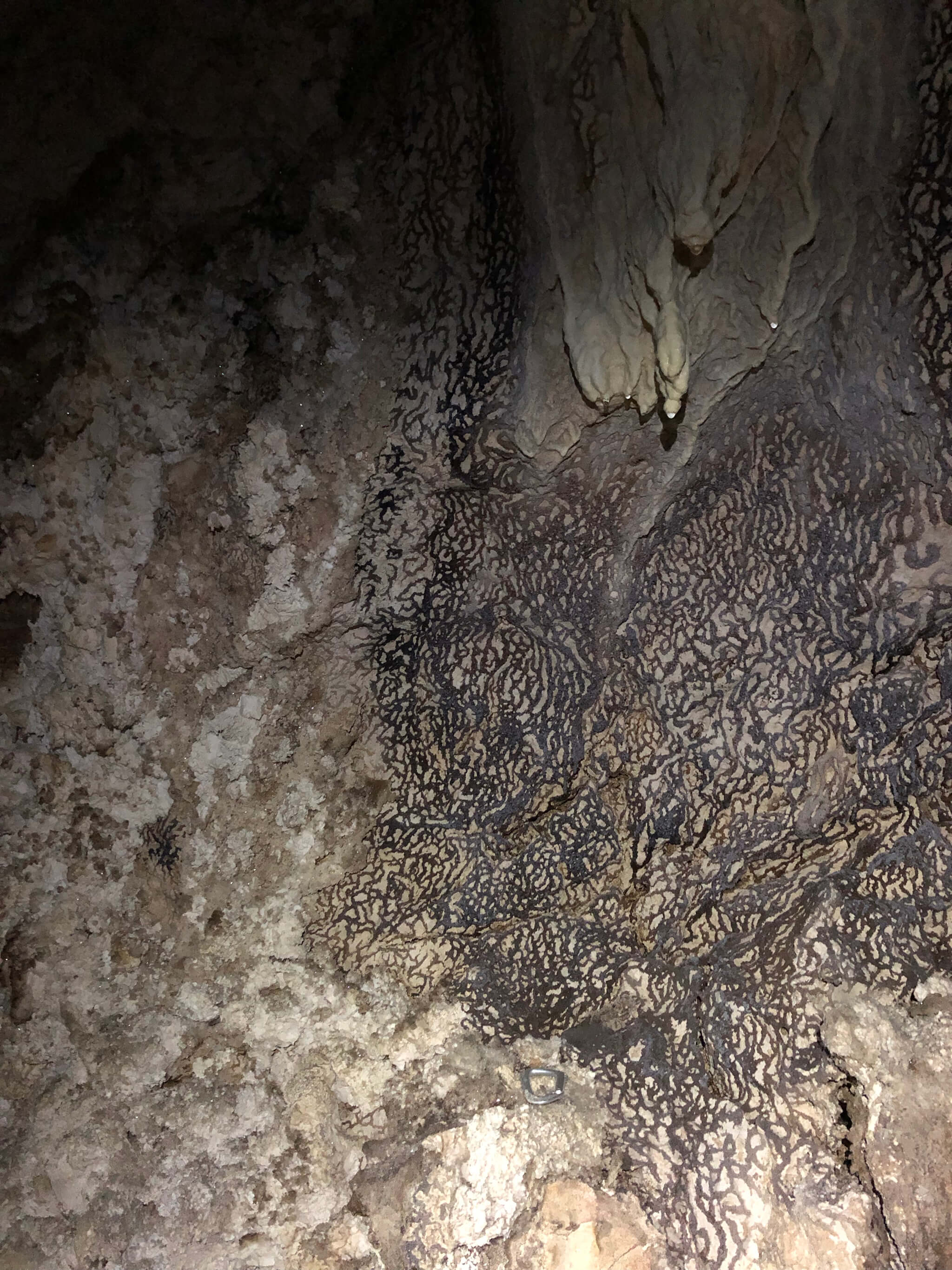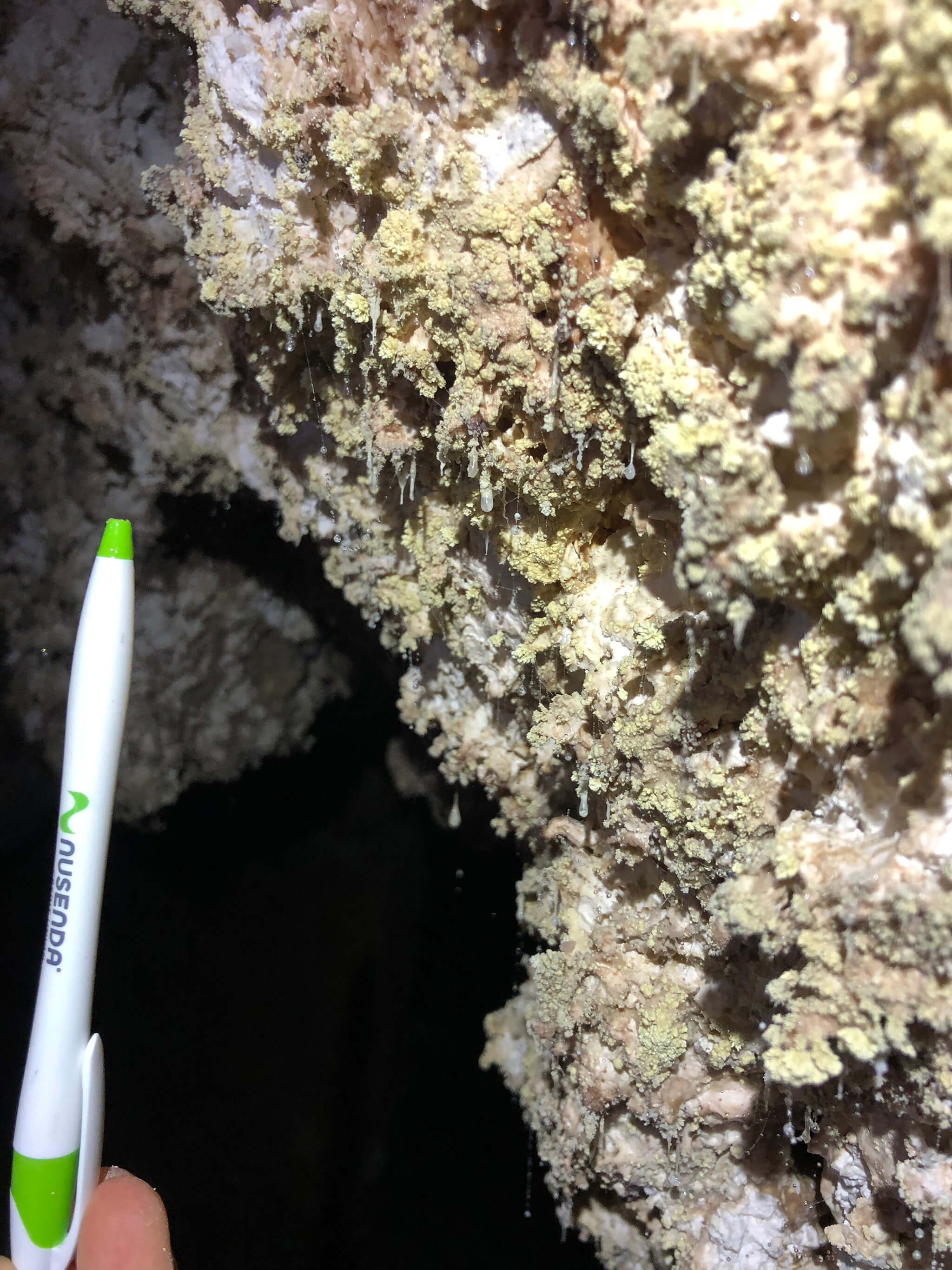Basic Research
Cave Origins
How caves form in the McCloud Limestone of northern California
The McCloud Limestone lies between Redding and McCloud California, parallel to the McCloud River. The many caves in the limestone have been popular with people for a very long time. The Wintu people actively used the caves for many purposes for thousands of years. In the early 1900s, paleontological excavations by geologists with the US Geological Survey revealed for the first time many extinct Pleistocene age animals, such as giant ground sloths.

NCKRI has partnered with Dr. Patricia Kambesis, at Western Kentucky University, and Dr. Jonathan Sumrall, at Fort Hays State University, Kansas, to examine the speleogenesis of the McCloud Limestone caves in northern California. The caves occur in the McCloud River valley and higher in the surrounding mountains. The research team has studied the shape of the cave passages using fractal analysis, mineralogy, water chemistry of local springs, cave sediments, and other factors to differentiate the two groups of caves: the river valley caves formed via carbonic acid dissolution while the higher elevation caves appear to have dissolved from sulfuric acid.
One group is found low on the landscape. Small caves located in the McCloud River valley sometimes contain streams with abundant creek sediments and scalloped walls. They indicate this group of caves formed through the action of streams with carbonic acid.
The second group is found high in the mountains. These caves have deep pits that require ropes to explore. The passages are often narrow, but there are also large rooms and many dead-end tunnels. There is almost no sediment or dirt, and sometimes there are many massive speleothems. These characteristics tell us the caves likely formed through sulfuric acid in upward rising waters that may also have been warm or hot. The source of the minerals to make the acid and the heat for the water probably came from the nearby Mt. Shasta volcano complex between 500,000 and 700,000 years ago.
Final work on this project is now underway with analysis of the cave maps and rock samples. The team is planning to publish a professional paper on the caves and their origins in 2021.
Karst Groundwater in Dry Climates
Characterization of the San Solomon Springs’ Aquifer, Texas
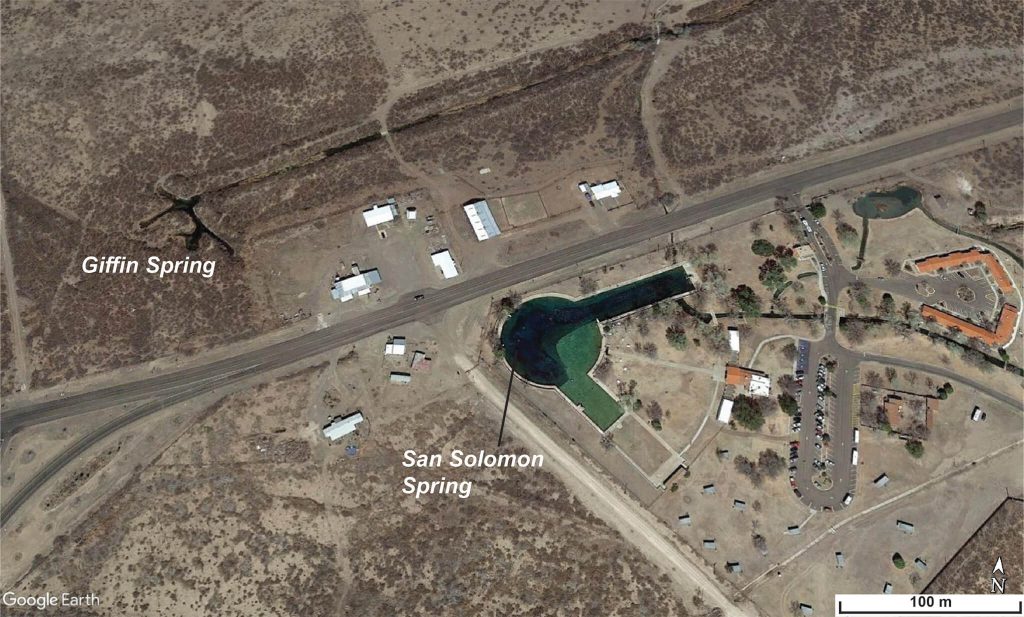
The San Solomon Spring Group is a series of six karst springs that discharge groundwater from Cretaceous limestones along the northeast flank of the Davis Mountains in West Texas. Apache Corporation is in the early stages of developing a significant oil and gas discovery in the area. It is funding this study as part of its effort to avoid compromising water resources and water quality of the San Solomon Springs. The first phase of this study is described in our Applied Science section.
The springs and related groundwater provide water resources for much of the agricultural activity in southern Reeves County, Texas. The farthest upgradient spring discharges from Phantom Lake Spring Cave, currently the deepest underwater cave in the United States. The main San Solomon Spring serves as a giant swimming pool and the centerpiece of Balmorhea State Park, another critical part of the local economy. The springs also provide habitat for several federally listed endangered species, including the Comanche Springs pupfish (Cyprinodon elegans) and Pecos gambusia (Gambusia nobilis).
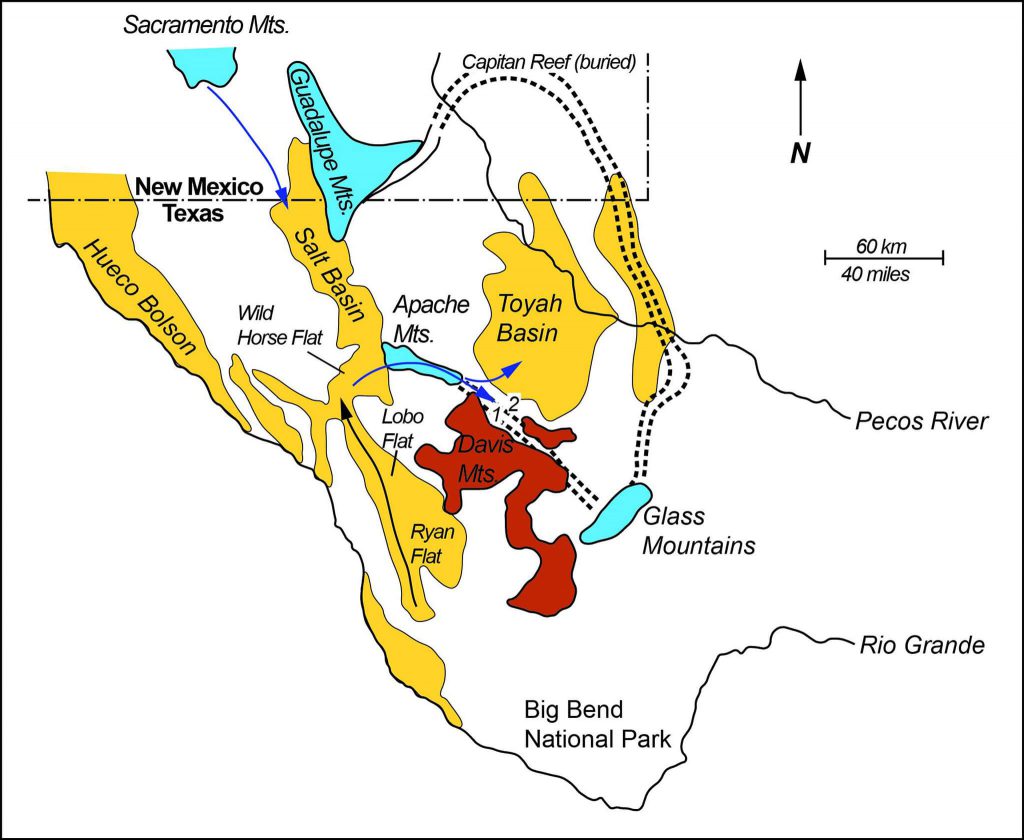
In 2013, NCKRI personnel conducted a dye trace of the system, injecting uranine, a non-toxic fluorescent dye, into Phantom Lake Spring Cave. Six days later, the dye appeared in the pool at Balmorhea State Park. This indicates the groundwater flowed through karstic conduits in the limestone at a rate of approximately 1,000 m/day. Although hydrogeologists working in the area generally accept a regional conceptual model for the aquifer (shown in the map above), specific details of this karstic system are not well known.
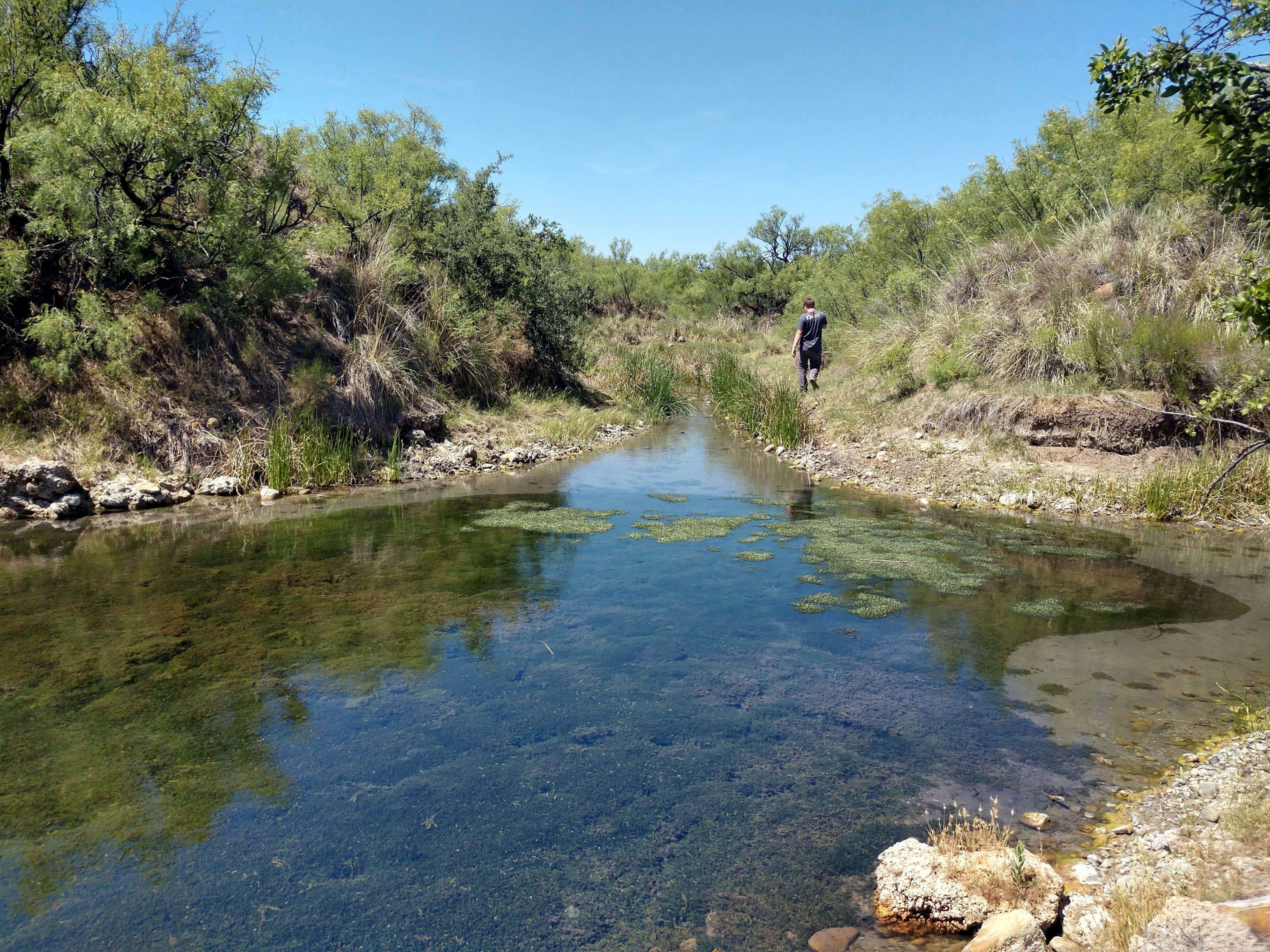
NCKRI’s hydrogeologist Dr. Lewis Land and Cave and Karst Science Specialist, Michael Jones, started a detailed karst study of the San Solomon Springs in April 2019. Currently, the project has two main parts. First, they conducted a series of electrical resistivity surveys (a type of geophysical study to “see” what is underground) around the individual San Solomon springs. This work allows them to locate any major conduits and cave passages feeding water to the springs. Second, they began a highly detailed water chemistry investigation of the springs. This study also helps us better understand the “plumbing” network of this aquifer.
NCKRI’s study of this hydrologic system is important in a variety of ways. Most notably, karst aquifers in semi-arid to arid regions are understudied. This research will add to the understanding of aquifers in such areas. We also believe this investigation may establish superior protocols for characterizing karst aquifers in areas of oil and gas production. Such protocols would minimize or prevent any adverse impacts on human water supplies and endangered species habitat.
Microbes and Dyes
Does Groundwater Tracing Hurt Cave Microorganisms?
Dye tracing is a long-standing and powerful tool for studying karst aquifers. It involves placing a non-toxic fluorescent dye into the ground to see where and when it arrives. But what is “non-toxic”?
Fluorescent tracers have been tested for toxicity in animals. Some dyes are government-approved for use in food, drugs, and cosmetics. But bacteria have been tested rarely. Might they be harmed? This question concerns the US Bureau of Land Management (BLM).
Fort Stanton Cave, New Mexico, contains the spectacular Snowy River Passage, which has a pristine microbial ecosystem. BLM wants to protect this ecosystem but recognizes that the source of water in Snowy River, while hypothesized, is presently unproven and unknown. BLM sees dye tracing as a potentially great tool to delineate the drainage area for the cave but wonders if the dyes could harm the native microbes.
NCKRI has an Assistance Agreement with the BLM for cave and karst research. BLM added funds to that agreement so NCKRI could investigate this dye-microbe question. Most of the study is occurring through New Mexico Tech student Evelyn Byrd under the guidance of Dr. Thomas Kieft. Ms. Byrd evaluated those samples for the potential impact of the dyes on their microorganisms. She did this by assessing four fluorescent dyes commonly used in karst groundwater research: uranine, eosin, sulforhodamine B, and pyranine.
The project began with a trip into Snowy River to collect microbial samples for testing from the water, sediment, and crystals found in the passage. Ms. Byrd is now evaluating those samples for the potential impact of the dyes on their microorganisms. She does this by assessing four fluorescent dyes commonly used in karst groundwater research: uranine, eosin, sulforhodamine B, and pyranine.
The results so far suggest that only the highest dye concentrations (which would occur at the point of dye injection) inhibit microbial growth, and the microbes recover readily. The data do not indicate any single dye is less impactful than the others. However, further testing is underway and needed before the study reaches firm conclusions.
Frasassi Cave Microbes
The Frasassi Caves are a large and spectacular cave system in central Italy. With breathtakingly large underground rooms and beautifully decorated chambers, the caves are a popular tourist destination and one of the most visited show caves in Italy. And, aside from their underground splendor, the Frasassi Caves are also world renowned for their scientific importance, which is why NCKRI is studying them.
The Frasassi Caves formed in an unusual way. Most limestone caves are the result of carbonic acid. Carbonic acid is the weak acid that forms when carbon dioxide gas dissolves in water, creating a mixture that is slightly corrosive to limestone. But Frasassi is different. The Frasassi Caves were dissolved by sulfuric acid, a strong acid. Although sulfuric acid caves are rare, some well-known caves were formed by this process, including some large and impressive caves like Carlsbad Cavern and Lechuguilla Cave in New Mexico. However, these caves formed several million years ago. Frasassi is special because sulfuric acid corrosion is still actively going on today.
Here is how this process works. Frasassi is fed by groundwater springs with high levels of hydrogen sulfide. Hydrogen sulfide is the gas that gives rotten eggs their distinctive odor; it is also a highly reactive compound. Once hydrogen sulfide is exposed to oxygen, it is transformed into sulfuric acid by an oxidation reaction. This can happen in cave streams, or up on walls and ceilings after hydrogen sulfide evaporates into the cave atmosphere. When hydrogen sulfide is oxidized to sulfuric acid on cave walls, the mineral gypsum is left behind as a corrosion residue.
Life is especially important for the formation of the Frasassi Caves. The hydrogen sulfide that flows into the cave provides an abundant source of chemical energy for chemosynthetic bacteria and archaea. These chemosynthetic cave microbes live off hydrogen sulfide in the same way we humans live off organic carbon. At the cellular level, they can be thought of as “eating” hydrogen sulfide and “breathing” oxygen just as we eat sugar and breathe oxygen, and their metabolic waste products are elemental sulfur and sulfuric acid. As microbes use hydrogen sulfide in the cave, they produce sulfuric acid at much faster rates than it would occur otherwise, and in doing so, they substantially speed up cave formation.
Microbial life in the cave is important in other ways as well. Not only do they help form the cave, but are the base of a food web that supports entire subterranean ecosystems based on chemical energy from sulfide. Life is especially robust right at the cave water table where the sulfidic groundwaters mix with oxygen. Microbial growth in the streams and on the walls support consumers that include a variety of invertebrate animals, many of them unique to the cave. Animal life in Frasassi includes (but is not limited to) spiders, isopods, springtails, snails, copepods, ostracods, oligochaete worms, and planarian worms (flatworms). In an exciting discovery, researchers found that the most abundant invertebrates in the cave, an amphipod in the genus Niphargus, have a symbiotic relationship with a specific type of chemosynthetic bacteria. The Frasassi Caves are an oasis for subsurface life.
Some of the microbial life in Frasassi is unusual and extreme. Highly acidic biofilms dangle from the cave walls and ceilings, often right above cave streams where hydrogen sulfide is rapidly degassing. Because of their shape and texture, these biofilms are known as “snottites.” They are created by colonies of acid-adapted microorganisms that live off hydrogen sulfide gas from the cave air. Snottites have a pH of less than 1, which is more acidic than the acid in your stomach, so the microorganisms that create and colonize these biofilms have special adaptations to survive in such extreme acid. Such acid-adapted organisms are known as acidophiles (acido = acid, phile = love), and these and other microorganisms that are found in harsh environments are known more generally as “extremophiles.” Many of the extremophilic bacteria and archaea in snottites are novel, and studying these communities is helping increase our knowledge of the diversity of life on Earth.
Diverse microbial communities thrive throughout the cave. In cave streams, chemosynthetic microorganisms feed on dissolved hydrogen sulfide and form white biofilms that cling to submerged rocks and coat sediments. On the walls, other acidophilic microorganisms live on the gypsum wall crusts near snottites. In places where gypsum wall crusts give way to exposed limestone, patterned wall deposits known as biovermiculations develop. Biovermiculations are meandering films of organic-rich sediment that stand up to 1 cm in relief from the limestone surface. They can be found far from the hydrogen sulfide gas sources. In fact, relict gypsum crusts and vermiculations in older cave levels may preserve information on the microbial processes that were active during earlier episodes of sulfuric acid cave formation. This is especially useful in distant areas of the cave where we know little about their past microbial processes. Even more mysterious are unusual and enigmatic rope-like microbial formations that are found deep in lakes in the most distant passages of the cave. There is still much to learn about life in the Frasassi Caves.


